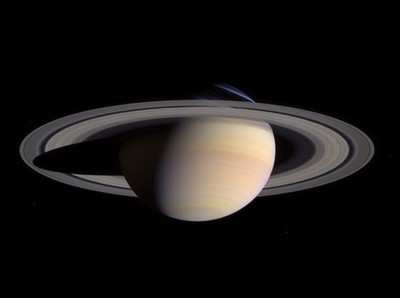A Varied Pattern Of Weather
Cassini scientists have discovered an unexpected menagerie of
clouds lurking in the depths of Saturn's complicated
atmosphere.

"Unlike the hazy, broad, global bands of clouds regularly seen in
Saturn's upper atmosphere, many of the deeper clouds appear to be
isolated, localized features," said Dr. Kevin H. Baines, a member
of the visual and infrared mapping spectrometer team from NASA's
Jet Propulsion Laboratory, Pasadena, CA. "They come in a large
variety of sizes and shapes, including circular and oval shapes,
donut shapes, and swirls."
These clouds are deep in the atmosphere, about 19 miles
underneath the upper clouds usually seen on Saturn. They also
behave differently from those in the upper atmosphere and are made
of different materials. They are made of either ammonium
hydrosulfide or water, but not ammonia -- generally thought to
comprise the upper clouds.
Scientists are using the motions of these clouds to understand
the dynamic weather of Saturn's deep atmosphere and get a
three-dimensional global circulation picture of Saturn. They have
mapped low-altitude winds over nearly the entire planet. Comparing
these winds to the winds at higher altitudes has led them to
conclude that substantial wind shears exist at Saturn's equator.
These shears are similar to wind shear observed by Galileo at
Jupiter, indicating that similar processes occur on both planets.
The new wind speeds measured by the mapping spectrometer shows that
winds blow about 170 miles per hour faster deeper down than in the
upper atmosphere.
Besides the donut-shaped and other localized cloud systems,
dozens of planet girdling lanes of clouds also appear in the new
images. Such lanes -- known as "zones"-- are commonly seen in the
upper clouds of Saturn and the other large planets. However, these
deeper-level lanes are surprisingly narrow and more plentiful than
seen elsewhere, including the upper clouds of Saturn. They also
have a much more thread-like structure than normally seen in
Jupiter or Saturn's upper atmosphere, with many of the thread-like
structures and swirls connected to discrete cloud "cells," which
look like convective cells on Earth.

The visual and infrared mapping spectrometer took
high-resolution, near-infrared images of the deep clouds during
four close passes of Saturn between February and July of this year.
The images were at a wavelength seven times greater than visible to
the human eye and five times greater than available to the Cassini
visual camera.
The scientists used a new technique that allowed them to image
the deep clouds silhouetted against the background radiation of
heat generated by the planet's interior. Until now, imaging clouds
in the depths of Saturn has not been practical since upper-level
hazes and clouds obscure the view.
"Instead of using sunlight as the source of radiation for
imaging the deep clouds residing underneath the obscuring layer of
upper-level clouds, we developed a new technique that uses Saturn's
own thermal heat as a source of light," said Baines. "It's like
looking down at a well-lit city from an aircraft at night, and
seeing the black areas against the city lights, which tells you
there is a cloud there blocking the light. Saturn emits its own
radiant glow, which looks much like the glow of city lights at
night."
Tracking these thermally-backlit clouds for several days enabled
the determination of wind speeds at the deepest levels ever
measured on Saturn.
"Understanding cloud development in the depths of Saturn will
sharpen our understanding of global circulation throughout Saturn
and of the major planets," said Baines.
These findings were presented in a news briefing at the 37th
Annual Meeting of the Division for Planetary Sciences meeting held
this week in Cambridge, England.
 ANN's Daily Aero-Linx (04.15.24)
ANN's Daily Aero-Linx (04.15.24) Classic Aero-TV: 'No Other Options' -- The Israeli Air Force's Danny Shapira
Classic Aero-TV: 'No Other Options' -- The Israeli Air Force's Danny Shapira Aero-News: Quote of the Day (04.15.24)
Aero-News: Quote of the Day (04.15.24) Airborne 04.16.24: RV Update, Affordable Flying Expo, Diamond Lil
Airborne 04.16.24: RV Update, Affordable Flying Expo, Diamond Lil ANN's Daily Aero-Term (04.16.24): Chart Supplement US
ANN's Daily Aero-Term (04.16.24): Chart Supplement US




